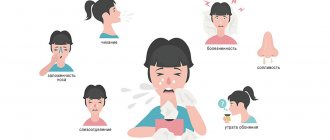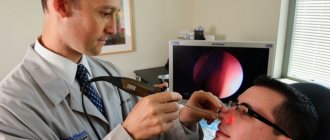Difficulty breathing and lack of nasal discharge are contradictory symptoms indicating that you are experiencing nasal congestion without a runny nose. As a rule, this uncomfortable condition is also accompanied by the following symptoms: lacrimation, pain in the facial area, sneezing and itching in the nasal cavity.
This problem significantly reduces the quality of life: the brain experiences oxygen starvation (respiratory hypoxia), increased fatigue is observed, endurance and performance decrease, and the quality of sleep also deteriorates, which negatively affects the nervous system.
After reading this article, you will learn the main causes of the problem, ways to diagnose the disease and understand how to treat nasal congestion without a runny nose.
Causes of nasal congestion without a runny nose
Difficulty breathing without other symptoms may have one of the following causes:
- Initial stage of the disease.
The respiratory tract is damaged by pathogenic bacteria; symptoms are temporarily absent. - Allergies
are the body’s immune response to dust, flowering plants, food, and animal fur. - Dusty and dry air.
- Violation of the shape of the nasal septum
is a congenital feature of the nose or acquired as a result of mechanical trauma. - Polyps
are benign neoplasms that form as a result of frequent colds, inflammation of the nasopharynx, allergic rhinitis, excessive consumption of alcoholic beverages, smoking, and the anatomical features of the structure of the nasal cavity. - A foreign object in the nose
causes pain and discomfort, sneezing and watery eyes. - Hormonal disorders
often occur in teenage girls, in women during pregnancy and on the eve of menopause - this condition does not threaten health. - The result of using medications.
For example, difficulty breathing due to repeated and prolonged use of vasoconstrictor drops or individual intolerance to the drug. - Rhinopharyngitis
is inflammation of the nasal passages, lymph nodes, the secreted secretion flows down the back wall of the patient’s throat, the nose remains dry. - Inflammatory processes of the nasal mucosa (different types of sinusitis, frontal sinusitis).
Swelling and purulent discharge block air access. - Oncological diseases of the brain and nasal canals
are a life-threatening health condition. The person may feel soreness, nausea, dizziness and weakness.
If you suspect cancer, you need to see a doctor (oncologist) and undergo a comprehensive examination.
University
→ Home → University → University in the media → Not a day without drops, or why your nose can’t breathe
At a reception with the head of the Department of Ear, Nose and Throat Diseases of the Belarusian State Medical University Anna Butzel , a 21-year-old guy. Since adolescence, he has been constantly instilling vasoconstrictor drops (decongestants) to relieve the painful feeling of severe nasal congestion. He always carries a bottle of life-saving medicine with him. At first, a two-time use was enough to ease breathing, but today the effect of the drug lasts only a couple of hours...
5 years of continuous use of vasoconstrictors is not yet a record. An elderly woman with “experience”... over 20 years came for a consultation.
“Unfortunately, there are more and more such patients - I encounter them every week,” comments Anna Cheslavovna. — The disease begins with one small mistake: taking decongestants (from any manufacturer) does not stop after 7 days of treatment. As a result, addiction develops. The mechanism of the problem is simple: if the nose is constantly “helped” with drops, it stops functioning independently. The vessels of the nasal cavity swell, the nasal turbinates increase in volume, the area of the nasal passages decreases, and the secretion of secretions increases. All this aggravates the discomfort and forces you to turn to drops again. Vicious circle.
It is important to note that vasoconstrictor drops also have side effects. For example, they stimulate a rise in blood pressure. Therefore, for those suffering from arterial hypertension or increased intraocular pressure, the duration of taking such drugs should not exceed 5 days.
— What is the reason for the popularity of decongestants?
— Firstly, I assume that they are available, because they are sold without a prescription. Secondly, in the arrogance and frivolous attitude of patients towards themselves: many independently “diagnose” themselves and undergo treatment. If the congestion does not go away, they assume that they have an “allergy” and continue to instill the drug. Sometimes the inflammatory process in the upper respiratory tract is too serious to quickly overcome. But even in such cases, it is necessary to discontinue the vasoconstrictor drops and consult an otolaryngologist to find the true cause of the symptoms and appropriate therapy.
— What is the reason for the fact that nasal congestion worsens in the evening?
— At this time of day, a person’s activity decreases; he, as a rule, takes a horizontal position (lying on a sofa, bed), and in this position the blood flow in the vessels of the nasal cavity slows down. Since the tone of the vascular wall during rhinitis is weakened, the vessels and capillaries are no longer able to pump the incoming blood. Therefore, they swell, swelling increases, and breathing becomes difficult.+
— If addiction is evident, how can doctors help?
— Usually we are forced to resort to surgical treatment. Previously, we more often used the traditional lower conchotomy - partial or complete removal of the mucous membrane of the nasal concha to widen the nasal passage. Today, more gentle laser, cauterizing technologies have appeared in service. But when the patient does not have pronounced hypertrophy of the nasal turbinates, one wants to avoid intervention, since it sometimes entails a number of undesirable consequences: it can provoke dysfunction of the mucous membrane, the development of trophic processes manifested by dryness in the nose.
Every tenth patient with chronic vasomotor rhinitis develops drug dependence.
In recent years, nasal topical corticosteroid drugs have helped us a lot in the treatment of drug-induced rhinitis. They, of course, do not give a lightning-fast effect, but they treat the cause of congestion well. However, you cannot combine them with vasoconstrictor drops: in this case, you will not be able to get rid of the problem.
— What should people who are prone to vasomotor rhinitis remember?
— First of all, you need to realize that this is not a disease of the nasal cavity, but an ailment of the whole organism associated with the autonomic nervous system, which also makes itself felt by symptoms from the nose. Therefore, in order to get rid of the disease, you need to change your lifestyle, strengthening the ANS: carry out hardening procedures, move more, take a contrast shower. And if you keep old habits, then rhinitis will most likely continue to haunt you. It is important not to forget that treatment is not only about relieving symptoms, but also about influencing the cause of their occurrence, and such a process requires the patient’s diligence and time.
— To refuse drops means to experience a painful state of nasal congestion. And at night I would like to get a good night's sleep...
“I recommend that my patients who find themselves in a similar situation abruptly stop taking the drops, take a break for 2-3 days, and endure it. Believe me, this torment will pay off handsomely. 3 days of discomfort are better than years of “feeding” an addiction that will be difficult to get rid of. To relieve difficulty breathing, I recommend massaging the area of the external nasal concha with your fingers. Breathing exercises help (forced inhalation through the nose and exhalation through the mouth). The air itself has a bougie (expanding the passages) effect, the oxygen contained in it dries out the mucous membrane of the nasal cavity, and forcing inhalation trains and increases vascular tone. Try to fall asleep by raising your pillow higher. Be sure to take a hot foot bath with mustard powder before bed. The duration of the procedure is 5 minutes. This helps to redistribute the blood flow from the upper to the lower parts of the body, due to which the blood supply in the vessels of the nose decreases, swelling decreases, the nasal passages expand and breathing becomes easier.
— Is it unrealistic to fight chronic rhinitis without a scalpel and medications?
— Such an opportunity may appear soon. Recently, the Departments of Ear, Nose and Throat Diseases and Medical Rehabilitation and Physiotherapy of the Belarusian State Medical University have developed a physiotherapeutic method for the treatment of vasomotor rhinitis. We are currently observing the long-term results of treatment. If the result is successful, the method will be described in more detail Elena Kleshchenok Medical Bulletin , May 3, 2013
Share
Why is nasal breathing difficult for a child?
Not only adults, but also children face the above problem. Factors of nasal congestion in babies:
- Young children have narrow nasal passages and sometimes little oxygen is supplied, so they often breathe through their mouths;
- the mucous membrane is relatively dry, accumulations of dried secretions are the causes of nasal congestion and are observed in children from two years of age.
Common factors causing difficulty in nasal breathing in children are various types of inflammation of the mucous membrane, as well as foreign bodies (buttons, pieces of food, small parts from toys).
Surgery
In the context of chronic congestion and congestion without runny nose, surgical care takes precedence over medication. The remedies listed above obviously will not be able to eliminate polyps, adenoids or deviated septum. Main indications for surgical intervention:
- Adenoids.
- Polyps in the nasal cavity.
- Tumor formations of the nasopharynx.
- Choanal atresia and other defects.
- Deviation of the nasal septum.
- Foreign bodies in the nasal cavity.
- Hypertrophy of the nasal concha.
Almost all ENT operations are currently carried out minimally invasive endoscopically using reliable and safe methods of pain relief.
Diagnosis of nasal congestion
There is a large list of serious diseases that can be signaled by nasal congestion without a runny nose. Be careful with self-medication; first of all, we recommend that you consult a qualified specialist.
Home diagnostic methods depend on the specific disease.
| Symptoms, method of diagnosis | Disease |
| If after using vasoconstrictor drops there is no relief in breathing within 15 minutes | Drug-induced rhinitis |
| Difficulty breathing in one nostril. Lie on your side, after 15 minutes turn over to the other side. The congestion of the nostril (the one located above) does not go away, one-sided difficulty breathing is observed | Trauma, abnormal septum, or presence of a foreign object |
| Nasal congestion, swelling of the nasopharynx, weakness and high temperature | Infectious rhinitis |
| Difficulty breathing, sneezing, pain in the eyes, if a person enters a certain room, upon contact with certain substances | Allergic reaction |
| Vasoconstrictor drops have no effect, headache | Polyp formation |
| Difficulty breathing without ARVI symptoms in adolescent girls, pregnant women and women on the eve of menopause | Vasomotor rhinitis |
| Dry cough and inflammation of the throat mucosa without a runny nose | Sore throat, pharyngitis and other inflammatory diseases |
| Inhalation is accompanied by whistling, unpleasant sensations of sore throat, change in voice | Posterior rhinitis |
| Difficulty breathing is accompanied by shortness of breath, swelling, cough, headaches | Diseases of the cardiovascular system |
| Mouth breathing in infants, loud snoring | Physiological feature of newborns |
Other diagnostic methods require test results, so they must be carried out under the supervision of a specialist. Even if the cause of difficulty breathing has been established independently, the assumption must be confirmed by an ENT specialist. Otherwise, incorrect therapy can lead to a serious deterioration in the patient’s condition.
When contacting an ENT specialist, you will conduct a comprehensive examination, allowing you to determine the cause of the disease with a high degree of probability. At the first appointment, the patient is examined using an endoscope to detect foreign bodies in the nasal passages.
Then the doctor can prescribe laboratory tests - various tests, smears, bacteriological culture. After analyzing all the results, the ENT specialist will make a diagnosis. If necessary, additional ultrasound and x-rays are prescribed.
Diagnostic measures
Diagnosis and treatment of the nose in adults is carried out by an otolaryngologist. During the consultation, the ENT doctor pays great attention to collecting complaints and the patient’s life history. During the consultation, the doctor asks the patient about when the symptoms appeared, whether they were preceded by injuries, whether he suffers from chronic diseases, whether he recently suffered from infectious diseases, etc.
A direct examination of the nasal cavity begins with rhinoscopy, which allows you to determine whether there is swelling, whether there is a foreign body in the nasal passages, or helps to identify abnormalities in the structure of the nasal cavity.
Endoscopic examination allows you to see a complete picture of the nasopharynx.
Thanks to it, the doctor examines in detail those areas of the nasal cavity that cannot be seen during a classic examination.
At this stage, neoplasms and adenoids can be identified. If necessary, the patient is sent for an X-ray or MRI. You may also need to consult related specialists - an allergist, cardiologist, oncologist.
Correct diagnosis is possible only after all diagnostic measures have been carried out. After this, a treatment regimen is prescribed.
What is the danger of constant nasal congestion without a runny nose?
Chronic difficulty breathing through the nose leads to a number of negative changes in the body:
- reduction in the acuity of smell to its complete loss (sometimes without recovery);
headaches (oxygen starvation);- the chronic form of allergic rhinitis can provoke bronchial asthma;
- prolonged difficulty breathing in children can contribute to deterioration of hearing and smell, and cause mental retardation;
- the appearance of night snoring;
- failure in the blood circulation of the brain is a serious threat to life;
- lack of sleep, debilitating weakness, memory impairment, depression, apathy, prolonged nervous tension.
Prevention: to breathe easily
Most often, a clogged nose is the result of a frivolous attitude towards one’s own health. But many problems and complications can be avoided if you follow simple recommendations:
promptly treat any diseases of the ENT organs;- avoid hypothermia - dress appropriately for the weather;
- take vitamins and eat right;
- lead an active lifestyle;
- avoid stress.
IRS®19 drug for the treatment of chronic runny nose
One of the most important tasks of complex treatment of rhinitis is to increase local immunity. For this purpose, immunomodulators, for example, IRS®19, can be used.
Thanks to the local nature of action and the convenient spray form, IRS®19 successfully fights harmful microorganisms directly at the site of infection, thereby reducing the severity of inflammation. Bacterial lysates activate local immunity, due to which periods of exacerbation of chronic runny nose are significantly reduced6.
With regular use, the drug strengthens the body's immune properties, reducing the number of infectious diseases. Moreover, unlike vasoconstrictor sprays, the drug has a long-term effect that can last up to 3-4 months6.
The drug has virtually no contraindications and can be prescribed to children from 3 months of age. Therefore, IRS®19 has been widely used in pediatric otolaryngology6.
Treatment: how to help your nose breathe again?
Special medications, inhalations and traditional methods of treatment will help with this. These remedies are especially good as part of complex therapy - this way a positive result is achieved and consolidated faster. But if you are looking for a medicine that will not cause side effects, allergies or addiction, choose herbal formulations.
Now you can easily select drugs that contain safe components - extracts of medicinal plants. Pine, hops, ginger root, primrose, elderberry, gentian - what unites plants that are familiar to everyone? That's right, their properties. Here's how they deal with nasal congestion:
- block viruses and microbes entering the body;
- activate and strengthen natural immunity;
- relieve inflammation, swelling and pain.
If you constantly have a stuffy nose, look for the causes of this condition and eliminate them with the help of natural herbal remedies - and you will not need to experience discomfort year after year.
What happens in the nose, and what consequences can there be?
Nasal congestion without snot means that the mucous membrane covering the inside of the nasal passages is in an inflamed and dry state. Receptors can be irritated by a variety of factors. Inflammation causes blood to flow to the mucous membrane, causing swelling and nasal congestion.
If you do not pay attention to the problem for a long time, atrophic rhinitis may occur when the mucous membrane dries out and ceases to perform its key functions.
First aid
As soon as this disease begins to bother you, and the causes have not yet been identified, the following methods of struggle will be “first aid”:
- humidifying the air in the bedroom using a wet towel thrown over the radiator or a special humidifier device;
- a course of preventive intranasal sprays or drops based on herbs;
- warming the nose with boiled eggs, salt or under a “blue lamp”;
- washing with saline solution, saline solution, decoctions (calendula, chamomile);
- inhalations based on herbs (eucalyptus, mint, chamomile, calendula, fir);
- self-massage of the wings of the nose and bridge of the nose for up to 10 minutes.
Complications of chronic rhinitis
A constantly stuffy nose creates serious inconvenience - the brain does not receive enough oxygen, which causes high fatigue, irritability, decreased performance, and headaches. A stuffy nose interferes with sleep, which further aggravates the situation.
With a decrease in immunity, the infection spreads to the lacrimal duct and other respiratory organs - paranasal sinuses, nasopharynx, trachea and bronchi. In the most severe cases, infection may enter the bloodstream with the development of sepsis, the formation of purulent foci in the sinuses or brain. These are serious complications with a high risk of mortality.
Atrophic and hypertrophic rhinitis are characterized by pathological changes in the mucous membrane at the cellular level, which creates the preconditions for cancer.
Chronic runny nose in childhood contributes to the development of speech defects and malocclusion, and during pregnancy can lead to infection of the fetus.









